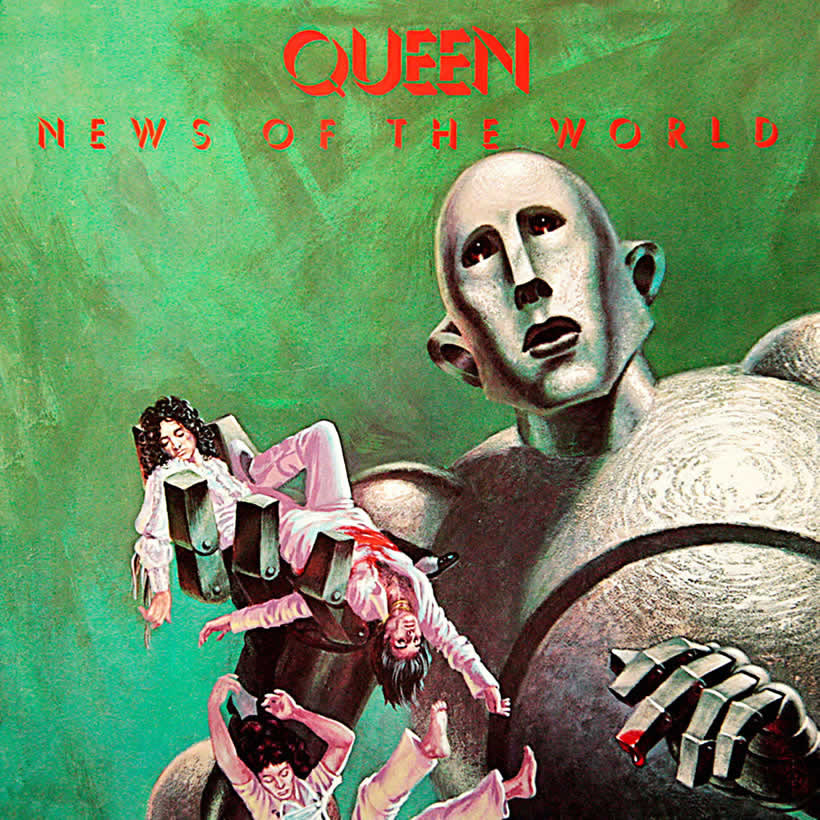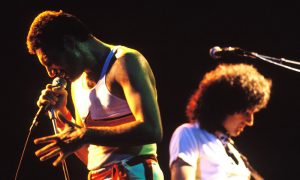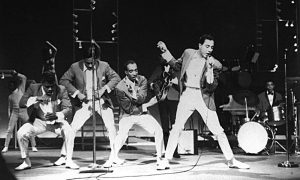With the cheers of the ecstatic Jubilee crowd at Earls Court in June 1977 still ringing in their ears, Queen prepared to create their sixth studio album. Booking time in Basing Street and Wessex Studios across July and August, with Mike Stone as their assistant producer, a decision was made to return to the “rootsier” sound of their first three recordings for what would become News of the World. Even so, the album would still be embellished with rich multi-tracked arrangements, and all the molasses and razor blade textures that guitarist Brian May could muster.
Listen to News of the World on Apple Music and Spotify.
With Freddie Mercury as the main conduit, the Queen approach was now as singular as anything in classic rock. There’s the glamour of David Bowie, the pyrotechnics and outrageous ambition of Jimi Hendrix, the sonic brute force of Led Zeppelin, along with the audacious harmonic élan of The Beatles and The Beach Boys; it was topped off with Mercury’s extraordinary charisma, whether in front of a microphone or sat at the piano. While it was at odds with his everyday modesty and reticence, it gave Queen a sonic palette quite unlike anyone else.
Transforming their stadium sound onto tape
Significantly, the band were now adept at transforming their stadium sound onto tape, and each member was contributing more. In the creative stakes, both bassist, John Deacon, and drummer, Roger Taylor, were “key players.”
The honor of opening proceedings on News of The World went to Brian, and what an opening it is. “We Will Rock You” is the ultimate anthemic rock track with its stomping, clapping arrangement, beating a virtual a cappella tattoo (no bass and drums were harmed in the making of this particular track, though an alternative faster version with full band was also recorded). The ensemble’s backing vocals meshed perfectly with Mercury’s rallying cry, lead vocal, and May’s triple tape-looped guitar.
The genesis of the idea possibly came from an audience response when they played the Bingley Hall, Stafford, a few months earlier. May recalled the crowd dragging them back for an encore by singing the football hymn “You’ll Never Walk Alone” and the undiluted emotion and spontaneity of that event inspired this and “We Are The Champions.” Needless to say, both would be adopted as terrace chants and have been used on countless sporting events, both in stadiums and on our TV screens.
An adrenaline overdose
With overdubs and delay, “We Will Rock You” provided a two-minute adrenalin overdose that delighted and stunned listeners who dropped stylus on News of the World for the very first time on 28 October 1977. From the opening track, the album was made immediate, while the song itself became an essential addition to Queen’s gigs.
It’s followed by the natural accompaniment, “We Are The Champions.” Mercury’s power ballad, as revolutionary as any weapon in contemporary punk rock circles, threw down the gauntlet. It was chosen as the A-side to “We Will Rock You” upon release as a single, three weeks prior to the unveiling of News of the World. In 2011 it was voted the catchiest pop song of all time by a team of academics at Goldsmith’s College in London. The scientists observed thousands of volunteers to find out why certain songs inspired unabashed wedding guests and clubbers to belt out their favourites in public. You only have to hum this in your head and you’ll be reacting like Pavlov’s Dog.
The academics concluded that sing-along hits had four key elements: long and detailed musical phrases, multiple pitch changes in a song’s “hook,” male vocalists, and higher male voices making a noticeable vocal effort. To bring matters full circle “Champions” was used as the official theme song for the 1994 FIFA World Cup, held in the United States.
Getting audiences involved
Back to the track! If it was written as a conscious effort to involve the audience in the show, it worked to perfection. With Freddie providing a complex and jazzy piano part, reflected by 4 and 5-part vocal harmonies, along with an outrageously tricky lead line that’s belted out in rock form, as well as an operatic falsetto, the attention to detail belies the apparently visceral nature of the emotion. The bottom line was sales that have reached 5 million plus with the single peaking at No.4 in the US and No.2 in the UK.
The next track, “Sheer Heart Attack,” was semi-complete, but not finished in time for the 1974 album of the same name. Written by Roger, who sang lead on the demo, the band tinkered with the arrangement and decided Freddie was better suited to the main vocal, with Roger on back up. Still, this was Taylor’s baby, lyrically updated to provide a veiled riposte to the new wavers, who cast aspersions on the older guard. His rhythm guitar and bass were pre-eminent with Brian adding some vibrant riffs.
Unlikely inspiration
The intriguing “All Dead, All Dead,” a song by Brian, puzzled, with a lyric that includes the lines “You know my little friend’s all dead” and “I am old but still a child”. In fact, the doomy tone was part inspired by the death of a much-loved family cat! May sings and Freddie provides the lovely piano.
John Deacon brought “Spread Your Wings” to the summer sessions: a smart rock ballad that kept the four musicians on their toes with the writer’s acoustic guitar providing the melody to Mercury’s narrative. An unusual choice for a single, given the downbeat tenor of the lyric, it peaked at No.34 in the UK with the instrumental outro trimmed for radio purposes. It would reappear in 1979 as the flip to, “Crazy Little Thing Called Love,” a US chart topper and the band’s final 45rpm of the 1970s.
Roger Taylor’s “Fight From The Inside” was described by Rolling Stone magazine as, “like a slogan fired from a machine gun”, and a call for “a junta” crossed with an examination of punk sociology; later, Slash from Guns N’ Roses cited the jangling riff as an all-time high. As on “Sheer Heart Attack,” Roger borrowed John Deacon’s bass and pretty much delivered the piece as a solo effort.
A throwback to their club days
On the second side of the original record, Freddie’s “Get Down, Make Love” is an edgy, sensual, psychedelic powerhouse of a tune that is almost a throwback to Queen’s club days, though now expanded upon to emerge as a future stage favorite, with plenty of room for a drum solo. But if that is classic Queen with all the ingredients, “Sleeping On The Sidewalk” is quite a departure from their deliberately Anglo style. Brian May handles the tune like a Texan bluesman, with his witty lyric conjuring up a tale of wannabe trumpet player who goes from rags to riches and back again. A sly insight into the music business and its tendency to fashion talent, this has often been likened to ZZ Top and Eric Clapton.
John’s “Who Needs You” is another departure from the norm, with cowbell, maracas, and Spanish guitar, while May’s “It’s Late” is a bluesy three-part narrative concerning the woes of the road. The guitarist employs a hammering or tapping technique, which he credits to Billy Gibbons of ZZ Top, who probably lifted the idea from T-Bone Walker. Released as an edited single in some territories (not in the UK), the song was much-loved by Kurt Cobain and can be heard on the soundtrack to the acclaimed documentary Kurt Cobain: About a Son, in between tracks by Arlo Guthrie and Cheap Trick.
Freddie’s “My Melancholy Blues” is the perfect closer and many a romantic Queen fan’s most-loved song. An intoxicating jazzy piano blues, reminiscent of a smoky nightclub entertainer, a fantasy combination of Hoagy Carmichael and Ella Fitzgerald perhaps, this throws some moody stardust round the studio and features Mercury at his absolute best.
Three weeks before News of the World landed in stores Queen were back on tour. They kicked off with an almost hush-hush West End concert at the then recently renovated New London on the corner of Covent Garden’s Drury Lane and Parker Street. Famed for links to music hall, and musical drama in general, this was the ideal venue in which to shoot the famous video clip for “We Are The Champions” and a select fan club audience were treated to one of the last up close and intimate dates in Queen’s career.
In November, the band departed for North America with News of the World about to hit No.3. There would be memorable triumphs at Detroit’s Cobo Hall, legendary crucible for the rockiest acts on the planet, a return to Madison Square Garden, and a trip out West to Nevada and California. Christmas was spent back in Britain, no doubt pondering the impact of the Los Angeles Times’ review, one that complimented them on producing the “most spectacularly staged and finely honed show yet”.
The news was out. The world was waiting and didn’t we just love the Queen’s Jubilee year of 1977.




